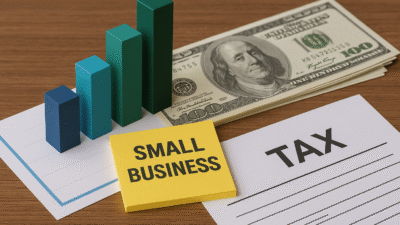Are You Overpaying the IRS Without Realizing It?
Did you know that nearly 70% of self-employed individuals miss out on critical tax deductions every year? According to IRS data and independent surveys, freelancers and small business owners overpay thousands in taxes simply because they’re unaware of lesser-known write-offs.
If you’re tired of writing big checks to the IRS, this post will walk you through the self-employed tax deductions most people miss, how to claim them legally, and what tools can make the process easier.
Financial Toolkit: What You Need to Claim Hidden Deductions
To catch every deduction, you need the right system. Here are your essentials:
- Accounting Software: Tools like QuickBooks, Wave, or FreshBooks track expenses and categorize them for easy filing.
- Receipt Scanner or App: Use Expensify, Shoeboxed, or your phone’s camera with Google Drive to organize documentation.
- Mileage Tracking App: MileIQ or Everlance automatically log drives and calculate vehicle deductions.
- Separate Business Account: Keeps personal and business spending cleanly separated for audits and expense clarity.
- Tax Organizer Spreadsheet: A simple Google Sheets template can help you visualize cash flow, deductions, and deadlines.
💡 Tip: Automate where possible to reduce the chance of missed entries and lost receipts.
Time Commitment: You’ll Spend Less Than You Think
- Initial Setup: 1–2 hours to install tools, open accounts, and organize documents
- Monthly Maintenance: 20–30 minutes per month to log and categorize expenses
- Quarterly Tax Filing: 2–3 hours (or less if using software or a CPA)
- Year-End Review: 3–4 hours to confirm deductions and reconcile statements
📆 Set monthly calendar alerts for “tax check-ins.” A little consistency pays off big time at year-end.
Step-by-Step: How to Uncover Hidden Tax Deductions
Step 1: Know What Counts as a Deduction
A deductible expense must be:
- Ordinary: Common and accepted in your trade or business
- Necessary: Helpful and appropriate for your business
Step 2: Log All Transactions
Don’t wait until April. Use an app or spreadsheet to categorize expenses daily, weekly, or monthly.
Step 3: Keep Documentation
Store digital receipts, bank statements, and client contracts. If audited, you’ll need to prove every deduction.
Step 4: Review IRS Categories
Many overlooked deductions fall under “miscellaneous” or “other.” Pay special attention to:
- Education
- Business gifts
- Utilities
- Subscriptions
Key Financial Metrics
- Average Self-Employed Deduction Savings: $4,800/year
- Home Office Deduction (Simplified): $5/sq ft, up to 300 sq ft
- Vehicle Deduction (2025): $0.655/mile
- Cell Phone/Internet Deduction: % based on business use
- Equipment & Tools: Up to $1,160,000 with Section 179
📊 Freelancers who log mileage and home office space claim 22–30% more deductions, according to Keeper Tax.
Smarter (and Legal) Deductions You Probably Didn’t Know
Here are the top tax deductions most people miss:
🏡 Home Office Deduction
Even a portion of your rent, mortgage interest, utilities, and repairs may be deductible.
🚘 Mileage and Vehicle Use
Whether you drive to client meetings or pick up supplies, track every business mile.
📱 Phone and Internet Bills
Deduct the business-use portion. For many, that’s 60–80%.
📚 Business Education
Courses, certifications, workshops, or industry-related books are deductible.
💻 Software and Apps
Zoom, Adobe, Canva, and other tools used for work count.
✈️ Travel and Meals
Travel for business, including airfare, hotel, and 50% of meals, is deductible.
🏥 Health Insurance Premiums
If you’re self-employed and pay your own premiums, deduct them 100%.
🧒 Hiring Your Kids
Children under 18 can legally work in your business and be paid up to the standard deduction ($14,600 in 2024) tax-free.
Real-Life Applications: Who Can Benefit
Case Study 1: Alex the Photographer
Alex claimed missed expenses like Lightroom software, mileage to shoots, and a portion of phone bills. He reduced taxable income by $8,200.
Case Study 2: Tasha the Freelance Editor
Tasha deducted 15% of her rent for a home office, Canva and Grammarly subscriptions, and courses on book editing—total savings: $3,900.
Common Mistakes That Cost You Thousands
- ❌ Mixing business and personal expenses
- ❌ Forgetting to track small recurring purchases
- ❌ Not keeping receipts or mileage logs
- ❌ Assuming expenses under $600 don’t count
- ❌ Not hiring a tax professional when your income increases
📉 The #1 IRS audit trigger is inconsistent reporting of income vs. expenses. Keep it clean, and you stay safe.
Maintenance & Optimization Tips
- ✅ Monthly Check-Ins: Log receipts, update deductions
- 🔄 Quarterly Reviews: Compare your current vs. projected income
- 🔔 Set Up Automation: Auto-import transactions from banks or Cash App
- 💼 Hire a CPA: Especially helpful once income exceeds $50K/year
- 📁 Use Cloud Storage: Keep all tax documents organized and backed up
Conclusion: Hidden Deductions = Hidden Profits
The best part about being self-employed? You control your income and your tax strategy. Knowing the self-employed tax deductions most people miss can change your financial outcome—turning tax season into a money-saving opportunity instead of a stress spiral.
Start now. Track everything. Ask questions. And don’t give the IRS a penny more than you owe.
👉 Want more tax-saving checklists and deduction cheat sheets? Subscribe to YourFinanceWorld.com for free tools, email tips, and expert insights.
FAQs: Self-Employed Deductions You Shouldn’t Miss
1. Can I claim a home office if I work from my dining room?
Only if the space is used exclusively and regularly for business. Occasional use disqualifies it.
2. Are business meals still 100% deductible?
Generally, no. Meals are 50% deductible, unless provided at a company event or for promotional purposes.
3. What if I don’t get a 1099 from a client?
You’re still required to report all income, even if you don’t receive a form.
4. What’s the best way to track deductions?
Use software like QuickBooks Self-Employed, or a spreadsheet + monthly calendar alerts.
5. Can I amend past returns if I missed deductions?
Yes! You can amend returns within three years and potentially get a refund.
6. Are subscriptions like Canva, Zoom, or ChatGPT deductible?
Yes—if they’re used for business operations, they qualify.




